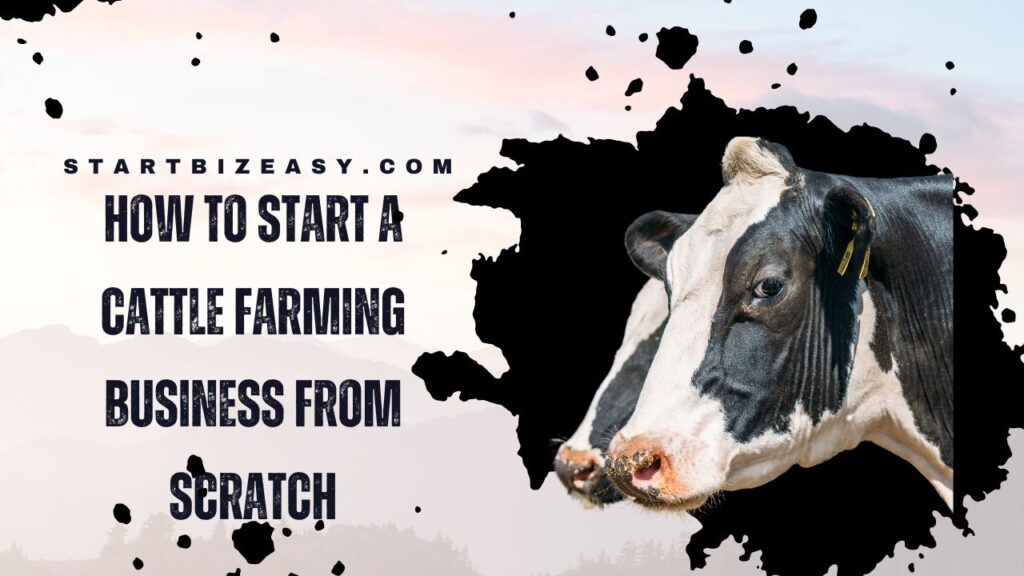
A cattle farm business involves the breeding, raising, and managing of cattle for various purposes such as meat production (beef cattle), milk production (dairy cattle), or breeding stock.
It is a multifaceted agricultural enterprise that requires careful planning, knowledge of animal husbandry, and effective management practices.
Generally, cattle farming is among the most profitable farming businesses to start with minimal cost.
In this article, we will reveal how you can start a cattle farming business from scratch.
Table of Contents
1. Research and Planning:
Before diving into cattle farming, you need to conduct thorough research and develop a solid plan. Begin by understanding the market demand for beef and dairy products in Nigeria. –There’s no need for apprehension, as Nigeria ranks among the world’s largest consumers of cattle meat, with over 3.31 million cattle slaughtered annually. Additionally, the dairy production market is valued at US $73 million according to “CSIRO Research”.
You also need to understand the different types of cattle farming as part of your research. Here’s a detailed exploration of the various types of cattle farms:
1. Beef Cattle Farms:
If your primary interest lies in meat production, beef cattle farming is the ideal choice. Beef cattle farms focus on raising cattle specifically for meat. The success of a beef cattle farm hinges on selecting suitable breeds known for their meat quality and growth rate, such as Angus, Hereford, or Brahman. These farms typically involve breeding, raising calves to maturity, and preparing them for market or slaughter. Beef cattle farming requires careful management of nutrition, health, and breeding practices to ensure optimal growth and profitability.
2. Dairy Cattle Farms:
Dairy cattle farms specialize in milk production. If you’re passionate about providing dairy products to consumers, this type of farm is your avenue. Dairy farming involves raising cattle breeds renowned for high milk production, such as Holstein-Friesian, Jersey, or Guernsey. The key activities include milking cows, managing lactation cycles, and ensuring optimal nutrition for milk production. Successful dairy farms prioritize the health and well-being of cows, efficient milking practices, and maintaining hygiene standards to produce high-quality milk for sale to dairy processors or direct consumers.
3. Mixed Farms:
For those interested in diversifying their operations, mixed farms offer a balanced approach by incorporating both beef and dairy production. Mixed farms capitalize on the strengths of both beef and dairy cattle breeds to cater to multiple markets and revenue streams. This type of farm requires careful planning to manage different breeding cycles, nutritional needs, and market demands effectively. Mixed farms can also explore opportunities for value-added products, such as selling beef and dairy products directly to consumers or processing milk into cheese and yogurt.
4. Organic and Sustainable Farms:
With increasing consumer demand for organic and sustainably produced food, organic cattle farms have gained popularity. Organic cattle farming emphasizes natural feeding practices, pasture management, and avoiding synthetic chemicals or antibiotics. These farms adhere to strict organic certification standards, appealing to health-conscious consumers willing to pay premiums for organic beef or dairy products. Organic cattle farming requires dedication to organic principles, maintaining soil fertility, and promoting animal welfare to ensure sustainable production practices.
5. Grass-fed and Pasture-raised Farms:
Grass-fed and pasture-raised cattle farms focus on raising cattle exclusively on pastureland, without relying on grain-based feeds. This farming method emphasizes the health benefits of grass-fed beef and dairy products, which are perceived as leaner and richer in beneficial nutrients. Grass-fed farms prioritize rotational grazing, maintaining pasture quality, and providing natural grazing environments for cattle. This type of farming appeals to consumers seeking environmentally friendly practices and high-quality, pasture-raised products.
You want to make sure you identify your target market, whether it’s local consumers, restaurants, or dairy processing companies. Analyze your competition to learn from their successes and challenges. Additionally, familiarize yourself with cattle breeds that thrive in Nigeria’s climate, such as White Fulani for dairy or Sokoto Gudali for beef.
Create a comprehensive business plan that outlines your goals, strategies, budget, and potential revenue streams. This plan will serve as your roadmap and help you secure funding from banks, investors, or government grants.
2. Secure Land and Resources:
The next step is to secure suitable land for your cattle farm. Choose a location with ample grazing land and a reliable water source. Ensure the land size can accommodate the number of cattle you plan to raise. It’s crucial to check the legal status of the land and obtain any necessary permits for agricultural use.
Once you have the land, invest in essential infrastructure. Erect strong fencing to protect and contain your cattle. Construct barns or sheds to provide shelter, especially during adverse weather conditions. Ensure you have a reliable and clean water supply and build storage facilities for feed and other supplies.
3. Acquire Cattle:
Once you have the land and resources in place, it’s time to acquire your cattle. Select breeds that are well-suited to Nigeria’s climate and your business goals.
Several cattle breeds are well-suited to Nigeria’s climate due to their ability to adapt to the country’s varying conditions. Here are some breeds commonly recognized for their suitability:
- N’Dama: Known for its heat tolerance and resilience to diseases common in tropical climates. N’Dama cattle are well-adapted to extensive grazing systems and can thrive in areas with limited resources.
- White Fulani (Adamawa Gudali): Indigenous to Nigeria, White Fulani cattle are prized for their heat tolerance, disease resistance, and ability to thrive in harsh environmental conditions. They are valued for both meat and milk production.
- Sokoto Gudali: Another native Nigerian breed, Sokoto Gudali cattle are known for their adaptability to hot climates and resistance to diseases. They are particularly favored for beef production.
- Red Bororo (Borana): Originally from the Borana plateau in East Africa, Red Bororo cattle have been successfully adapted to Nigerian conditions. They are noted for their heat tolerance, disease resistance, and good beef quality.
- Keteku: Also known as Muturu or Nkone cattle, Keteku are indigenous to the coastal regions of West Africa, including Nigeria. They are valued for their ability to thrive in humid conditions and their adaptation to low-input production systems.
These breeds have been selectively bred and adapted over generations to withstand Nigeria’s tropical climate, which includes high temperatures, humidity, and the common cattle diseases in the region. They are suitable choices for farmers looking to establish resilient and productive cattle farming operations in Nigeria.
Remember to purchase healthy and well-bred cattle from reputable breeders or livestock markets, because it has a direct impact on the success of your cattle farming business. Start with a manageable number of animals and gradually expand your herd as you gain experience and confidence in managing your farm.
4. Set Up Operations:
Setting up your farm operations involves establishing feeding and nutrition programs, health care routines, and breeding management practices. Provide your cattle with a balanced diet that includes grazing, hay, silage, and supplements. Develop a feeding schedule and ensure consistent access to clean water.
Implement regular health checks, vaccinations, and deworming schedules. Work with a veterinarian to manage diseases and health issues. Keep detailed records of each animal’s health, breeding, and production to monitor their performance and make informed management decisions.
Develop a breeding program to ensure a steady supply of calves. You can use artificial insemination (AI) or natural breeding methods. Monitor calving and provide necessary care to cows and newborn calves to maintain a healthy and productive herd.
5. Legal and Regulatory Compliance:
Ensure your business complies with all legal and regulatory requirements. Register your business with the Corporate Affairs Commission (CAC) in Nigeria.
Obtain the necessary licenses and permits for cattle farming. Adhere to local, state, and federal regulations regarding animal welfare, food safety, and environmental impact. Staying compliant will help you avoid legal issues and build a reputable business.
6. Marketing and Sales:
Marketing and sales strategies are critical to the success of your cattle farm. Identify your sales channels, whether it’s local markets, direct sales to consumers, or supplying to restaurants and processors. Consider joining agricultural cooperatives to access larger markets and improve your bargaining power.
Explore opportunities for selling value-added products such as cheese, yogurt, or specialty meats to increase your revenue streams. Develop a strong brand and build relationships with your customers to create loyalty and repeat business.
7. Financial Management:
Sound financial management is crucial for the success of your cattle farming business. Create a detailed budget covering initial setup costs, ongoing expenses, and projected income. Fortunately, starting a cattle business can be relatively inexpensive, as you can begin with just two young cattle: a female (heifer) and a male (bull calf) —which cost an average of 80,000 Naira each. With a total of 160,000 Naira, you can start this cattle farming business on a small scale.
However, if you want to start on a large scale, you should have a capital of at least 30 million Naira. With N160,000 you can start this cattle farming business on a small scale, but if you want to start on a large scale you must have a capital of nothing less than N30 million Naira.
The major disadvantage of starting on a small scale is the delay; you have to wait for the young cattle to grow to breeding age and start producing a sufficient number before you can begin selling. Heifers take about 15 to 18 months to reach sexual maturity and are ready for breeding, while bull calves take around 12 to 15 months. After they start breeding, you have to wait through a gestation period of about nine months, or roughly 283 days on average, depending on the breed. Most cattle give birth to one calf per pregnancy, with twins being very rare.
Additionally, the postpartum interval, or the period from calving to the next conception, is typically about 45 to 90 days. This means a cow can be ready for breeding again approximately 2 to 3 months after giving birth, though this can vary based on factors such as the cow’s health, nutrition, and overall management practices.
If we sum up the waiting time, it totals around 2 years and 1 month to 2 years and 5 months just to get an addition to the herd, not to start making a profit. Therefore, on a small scale, it could take about 5 to 6 years before you can start making money from your cattle farm. In contrast, a large-scale operation can start making money as early as 1 year and 6 months.
Part of your financial management should also include a plan for costs such as feed, veterinary care, labor, equipment, and marketing.
Maintain accurate financial records, including income and expenses. Track herd performance and productivity to make informed management decisions. Regularly review your financial performance and adjust your plans as needed to ensure profitability and sustainability.
Business Opportunities in the Cattle Rearing Business

Cattle rearing presents lucrative business opportunities worth exploring. Here’s a detailed exploration of the potential and rewards in the cattle rearing business.
1. Meat Production:
Raising cattle for meat production is a primary opportunity in the industry. Nigeria has a growing population with an increasing demand for beef, making meat production a stable and profitable venture. By focusing on beef cattle breeds like Sokoto Gudali or Red Bororo, you can cater to both local consumer markets and larger-scale meat processors.
2. Dairy Farming:
Dairy farming offers another significant opportunity in cattle rearing. Nigeria imports a large portion of its dairy products due to insufficient local production. By investing in dairy cattle breeds such as White Fulani or Holstein-Friesian, you can contribute to meeting the country’s dairy needs. Producing and selling fresh milk, yogurt, cheese, and other dairy products can be highly profitable, especially if you establish a reliable customer base.
3. Value-Added Products:
Beyond meat and dairy, there are opportunities to produce value-added products. Consider processing cattle by-products like hides and skins for leather production. Additionally, explore the market for organic fertilizers made from cattle manure, which is in demand by organic farmers and gardeners.
4. Transport and Logistics:
Cattle transportation is a critical aspect of the business, especially when moving cattle from farms to markets or processing facilities. Establishing a transportation and logistics service for cattle can be a profitable niche. This includes owning or leasing livestock trucks and offering reliable and safe transportation services.
5. Feeding and Nutrition:
The demand for quality cattle feed and nutritional supplements is ever-present in the industry. Investing in or partnering with feed mills that produce nutritious cattle feed can be a lucrative business opportunity. Additionally, offering consultancy services on optimal feeding practices for cattle farmers can create another revenue stream.
6. Technology and Innovation:
There’s room for innovation in cattle farming through the adoption of modern technologies. Developing or investing in technologies such as automated feeding systems, smart monitoring devices for cattle health, or software for farm management can enhance efficiency and productivity. These innovations not only improve farm operations but also present opportunities for technology-driven businesses within the agricultural sector.
7. Environmental Sustainability:
With increasing global awareness of environmental sustainability, there’s a growing market for sustainably produced beef and dairy products. Implementing sustainable practices on your cattle farm, such as rotational grazing and water conservation measures, can differentiate your products in the market. You can also explore carbon credit programs or partnerships with eco-conscious consumers and businesses.
The cattle rearing business in Nigeria offers diverse and promising opportunities for entrepreneurs. By leveraging these opportunities with careful planning, strategic investment, and dedication to quality, you can build a successful and sustainable cattle farming enterprise in Nigeria and in your own country.
Challenges and Considerations of Cattle Farming Business in Nigeria
Venturing into cattle farming in Nigeria offers significant opportunities, but it is essential to be aware of the challenges and considerations involved. Understanding these factors will help you prepare and strategize effectively, ensuring the success and sustainability of your business. Here’s a detailed exploration of the challenges you may face and key considerations to keep in mind:
1. Climate and Environmental Conditions:
Nigeria’s diverse climate can present challenges in cattle farming. Depending on your location, you might face extreme weather conditions such as prolonged dry seasons or heavy rains. These climatic variations can impact the availability of pasture and water resources, affecting the health and productivity of your cattle. To mitigate these challenges, consider implementing irrigation systems, drought-resistant forage crops, and efficient water management practices.
2. Feed and Nutrition:
Ensuring a consistent and nutritious feed supply is crucial for the growth and productivity of your cattle. The fluctuating availability and cost of feed ingredients can pose a significant challenge. You need to develop a sustainable feeding strategy that balances grazing with supplemental feeding during periods of pasture scarcity. Investing in high-quality feed and exploring local feed production options can help stabilize your feed supply.
3. Health and Veterinary Care:
Maintaining the health of your cattle is paramount, but access to veterinary services and medicines can be limited in some regions. Disease outbreaks, such as foot-and-mouth disease or bovine tuberculosis, can devastate your herd and result in substantial financial losses. Establish a robust health management plan that includes regular veterinary check-ups, vaccinations, and biosecurity measures to prevent and control diseases. Building a relationship with a reliable veterinarian is essential for timely and effective care.
4. Breeding and Genetics:
Achieving optimal breeding outcomes requires careful selection of cattle with desirable traits. However, sourcing high-quality breeding stock can be challenging and expensive. You need to focus on genetic improvement through selective breeding and possibly investing in artificial insemination technologies. Maintaining detailed breeding records and monitoring the performance of your herd will help you make informed decisions and enhance the genetic quality of your cattle.
5. Market Access and Price Fluctuations:
Accessing markets and securing fair prices for your products can be challenging. Fluctuations in market prices for beef and dairy products can affect your profitability. To address this, develop a strong marketing strategy that includes diversifying your sales channels. Building relationships with local markets, processors, and consumers can provide more stable and lucrative market opportunities. Additionally, consider value-added products to enhance your revenue streams.
6. Financial Management:
Effective financial management is crucial for the sustainability of your cattle farming business. You need to carefully plan and manage your finances, including budgeting for initial investments, operating costs, and unforeseen expenses. Access to credit and financing options may be limited, so explore various funding sources such as agricultural loans, government grants, and partnerships with investors. Maintaining accurate financial records and regularly reviewing your financial performance will help you make informed decisions and ensure the financial health of your business.
7. Labor and Expertise:
Finding and retaining skilled labor can be challenging, especially in rural areas. Cattle farming requires expertise in animal husbandry, health management, and farm operations. Investing in training for yourself and your employees is essential to build the necessary skills and knowledge. Consider partnering with agricultural training centers or organizations that offer technical support and capacity-building programs.
Essential Equipment for Cattle Farming
Embarking on your journey in cattle farming requires careful preparation, and having the right equipment is crucial to the success of your operations. Here, I will outline the essential equipment you will need to ensure the health, productivity, and efficiency of your cattle farm.
1. Fencing and Gates:
Effective fencing is fundamental to contain and protect your cattle. Invest in durable materials such as barbed wire, electric fencing, or high-tensile wire. You’ll also need sturdy gates to facilitate easy access to different sections of your farm. Ensure that your fencing is high enough to prevent cattle from escaping and strong enough to withstand pressure from the herd.
2. Watering Systems:
Providing a reliable and clean water supply is essential. Consider installing automatic waterers, which ensure that your cattle have constant access to fresh water. You might also need water troughs placed strategically around your pastures and barns. For farms with large grazing areas, portable water tanks and mobile watering systems can be highly beneficial.
3. Feeders and Feeding Equipment:
Efficient feeding systems are crucial to maintaining the health and growth of your cattle. Invest in high-quality feeders, including hay feeders, grain feeders, and mineral feeders. Depending on the size of your operation, you might need automated feeding systems that can distribute feed at scheduled times. Ensure that your feeding equipment is easy to clean and durable enough to withstand daily use.
4. Handling and Restraining Equipment:
Handling and restraining your cattle safely is essential for medical treatments, vaccinations, and routine checks. You will need equipment such as cattle chutes, head gates, and squeeze chutes. These tools help immobilize the cattle, making it safer and easier to perform necessary procedures. Additionally, having cattle prods, sorting panels, and gates will facilitate efficient handling and movement of your herd.
5. Shelter and Housing:
Providing adequate shelter is vital, especially during extreme weather conditions. Construct barns or sheds to protect your cattle from rain, wind, and excessive heat. The shelter should be well-ventilated and spacious enough to accommodate your herd comfortably. Consider adding bedding materials like straw or wood shavings to enhance comfort and cleanliness.
6. Health and Veterinary Supplies:
Maintaining the health of your cattle requires a well-stocked supply of veterinary equipment and medicines. Essential items include syringes, needles, dehorning tools, hoof trimmers, and calving kits. You should also have a range of veterinary medications, vaccines, and treatments for common diseases and parasites. Building a relationship with a local veterinarian will ensure you have access to professional advice and emergency services.
7. Transportation:
Efficient transportation is necessary for moving cattle to markets, veterinary clinics, or between pastures. You will need a reliable livestock trailer that is easy to load and unload. Ensure the trailer is well-ventilated, secure, and appropriately sized for the number of cattle you plan to transport.
8. Milking Equipment (for Dairy Farms):
If you are focusing on dairy farming, invest in high-quality milking equipment. This includes milking machines, storage tanks, and cooling systems to preserve milk quality. Automated milking systems can enhance efficiency and hygiene. Additionally, you will need cleaning equipment to maintain the cleanliness of the milking parlor and equipment.
9. Pasture Management Tools:
Effective pasture management is crucial for sustainable cattle farming. Equip yourself with tools such as mowers, seeders, and sprayers to maintain and improve your pastures. Soil testing kits can help you monitor soil health and make informed decisions about fertilization and grazing practices.
10. Record-Keeping Systems:
Accurate record-keeping is essential for managing your farm effectively. Invest in farm management software or record-keeping systems that allow you to track cattle health, breeding, feeding schedules, and financials. This information is vital for making informed decisions and improving the overall efficiency of your operations.
Read Also:
- How to Start a Successful Goat Farming Business in Nigeria
- Rabbit Farming: How to Start & Make Money
- Start a Profitable Pig Farming Business in Nigeria: Make 500k to a million monthly
- How to Run a Profitable Snail Farming Business in Nigeria: Step-By-Step Guide
- How to Start a Profitable Catfish Farming Business in Nigeria: Step-by-Step Guide
- Step-By-Step Guide to Starting a Profitable Poultry Farming Business in Nigeria





